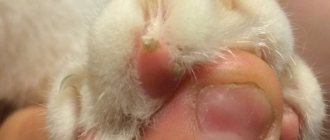Warts are skin lesions that vary in appearance, although they typically appear as bumps protruding from the skin and are usually spherical in shape.
Warts can appear in children and teenagers (about 30% have warts) or in adults with weaker immune systems.
In addition to common warts, these lesions can also be caused by infection with the human papillomavirus, also known as HPV. These warts are the result of an infection of the epidermis, or top layer of skin, caused by the human papillomavirus.
But not only people, but also many animals become infected with warts. There are more than 100 types of viruses that can cause warts in animals such as cats. However, each class of animal is more or less susceptible to certain types of viruses and tumors that cause these bumps.
In cats, warts usually appear in groups, forming an area affected by several lesions of this type. Usually the lumps that appear on cats are benign, but it is true that some of them are actually tumors. Additionally, if your cat is over ten years old, it is recommended to see a veterinarian, as papillomas can contribute to the development of squamous cell carcinoma (SCC). This disease is also known as Bowen's disease.
© shutterstock
What causes the appearance and development of warts in cats?
The papillomavirus is transmitted, among other things, through direct contact with infected animals.
There are many cats that are carriers of various viruses, including the papilloma virus. The fact that these cats are carriers does not necessarily mean that they should show any symptoms of the disease, but rather that they may be completely asymptomatic, meaning completely healthy. In other words, the owner may not know that their cat is a carrier because the cat will not have warts or other signs that it is a carrier.
The oldest cats are most at risk of contracting this disease, as they may have a weaker immune system. On the other hand, a very young cat may not have the same defenses as a middle-aged cat, or its immune system may not be fully mature. For these reasons, if any of these cats become infected with HPV, they may eventually develop Bowen's disease or SCC.
Human papillomavirus can also be transmitted through contact with toys, food, water bowls and bedding from an infected or carrier cat.
Transmission occurs when the virus enters the cat's body. This will happen if the virus comes into contact with any area of the cat's skin that is wet, injured or open, such as a cut, tick, mosquito or flea bite, burn, etc.
When the virus is inside a cat's body, it attacks its cells, disrupting their normal functioning. What actually happens is that this virus causes the cat's cells to divide more frequently than normal. At the same time, the virus turns on some genes that promote the growth of certain cells, such as cancer cells, and turns off other genes that prevent or control the spread of those cells. Consequently, this virus disrupts the normal functioning of cells and can lead to the growth of malignant cells.
In any case, warts usually do not cause any problems and disappear when your cat becomes immune to these attacks, which happens spontaneously or autonomously.
Possible complications
As already mentioned, warts in animals can lead to serious consequences. Papillomatosis is often accompanied by itching. Animals scratch the affected areas and tear off tumors. Bleeding ulcers appear on the skin. This can lead to malignant cell degeneration and skin cancer.
Oncological diseases are the most dangerous, but far from the only complication of papillomatosis. When large warts are injured, severe bleeding may occur, leading to anemia. Also, sores and scratches can become infected and fester.
Can warts cause discomfort or even illness in a cat?
The side effects of warts will largely depend on your cat's health. Usually warts don't cause any more problems, just an irritation while they last, but if your cat can't mount a sufficient immune response, the warts may be causing some pathology or they may not go away. Normally immunocompromised cats are cats that have had a previous illness or have a serious infection or have been exposed to radiation.
On the contrary, when your cat is healthy, warts usually do not spread to other parts of the body and also disappear on their own.
In cases where the warts do not go away or if you want to remove your cat's warts as soon as they appear, you can contact your veterinarian for surgical removal. This is especially recommended when the warts are inflamed or infected, as they need to be removed as soon as possible to prevent them from causing more serious consequences for your cat.
Diagnostics
The diagnosis is made comprehensively based on clinical signs, analysis of medical history and laboratory diagnostic methods. If you find a wart in a cat, it is very important not to self-medicate and immediately contact a veterinary clinic: any seemingly harmless skin tumor can turn out to be a fast-growing malignant tumor (for example, mastocytoma). In the presence of a malignant tumor, the start of treatment plays an important role in the prognosis of the disease and the life expectancy of the pet.
Source - otvet.mail.ru
For a preliminary diagnosis, routine diagnostic methods can be performed - blood tests, cytology from the affected area (a so-called fine-needle biopsy is performed). But to confirm the diagnosis, a full biopsy is necessary: for this analysis, a piece of the formation is taken (or the entire wart, if it is small) and submitted to the laboratory for histology. To identify papillomavirus, it is necessary to perform histology with immunohistochemical staining of the material.
Source - otvet.mail.ru
Also, the PCR diagnostic method is currently used to detect the papillomatosis virus in a cat and to determine the type of virus. However, it is worth noting that this test can show a positive result in a clinically healthy cat, which can be explained by the carriage of the virus and the pet’s strong immunity.
In any case, if you notice a mole on a cat, be sure to show it to a veterinarian!
Are warts transmitted from cats to humans?
Warts are usually contagious, but only between animal species or people. That is, warts are specific bumps or growths of each species, so they can be contagious between the same species, but not between different ones.
Human warts are also contagious, but for that matter, you don't have to worry about your cat's warts—there's no risk of your cat getting warts. In any case, if you have more cats, be careful because the warts can spread to each other.
Reviews
Animal owners leave positive reviews about the treatment of papillomatosis with novocaine injections. After 2-3 injections, the warts completely disappeared. However, cat owners emphasize that after the course of treatment it is necessary to give their pets immunomodulators. Otherwise, papillomas may grow again.
You can find positive reviews about the treatment of papillomatosis with ascorbic acid injections. Vitamin therapy helps strengthen the immune system and mobilize the body's defenses to fight the virus. However, such remedies are effective only for mild forms of the disease.
Experienced cat breeders recommend resorting to surgical methods for treating warts only in extreme cases, if the tumor prevents the animal from breathing or eating. Surgery is also necessary if there is a risk of malignant changes. This is a rather expensive procedure that is not available to all cat owners.
The pharmaceutical drug “Cryopharma” also received good reviews. It comes in aerosol form and contains a mixture of dimethyl ether and propane. This product is used to freeze and remove warts. Its action is similar to that of liquid nitrogen. However, this drug is intended for humans. Before using it on animals, you should consult your veterinarian. Only a specialist can take into account the indications and contraindications for the use of an aerosol.
How to identify warts in a cat?
Cats often have several bumps throughout their body, most of which are benign. This fact makes it difficult to diagnose warts because we will have to rule out the growth behind the bump if it is benign or malignant. We may find a new lump on our cat's body and not be sure whether we should worry or not.
© shutterstock
First of all, to deal with your cat's warts, it is important to get help from a veterinarian. In general, you should visit your veterinarian regularly so that you can monitor your cat's health. In the case of warts, veterinarians will typically analyze any lump that meets any of the following conditions: that it is growing in size, that is bothering the cat, or that the lump is changing in appearance. To allow your veterinarian to evaluate whether these factors coincide, it is highly recommended that you have regular consultation appointments so that your veterinarian can eventually get to know your cat and can make a more complete diagnosis.
Veterinarians often distinguish warts from other lumps with the naked eye because they are lumps that often have a similar appearance that are easy to identify. However, in more complex cases or if the veterinarian is in doubt, there are procedures that can determine with greater certainty whether the lump in question is a wart or another type of lump.
This procedure is a fine needle aspiration biopsy known as FNA. This treatment consists of suctioning or obtaining a tissue sample from the tumor so it can be examined later. Tissue collection is done using a needle that turns on a syringe so that it draws in a sample of cells from the tumor of interest. This sample will be examined by a veterinarian using a microscope.
Apart from this procedure, there are other similar procedures that can also identify warts. A biopsy may be performed, which is the most thorough examination of a removed tissue sample. This will be done when, after the FNA procedure described in the previous paragraph, a more detailed analysis is required to conclude whether the removed tissue is part of a wart or not.
In any case, it is also true that in many cases the warts are small, with the help of which the lump can be completely removed and examined as a whole. This procedure is known as histopathology.
Traditional methods
Is it possible to treat papilloma in cats at home? You should not rely completely on folk remedies. After all, papillomatosis is a viral infection, and it is impossible to do without drug therapy. Folk remedies can be used only after consulting a specialist. They are used only in combination with veterinary drugs and sometimes with surgical treatment.
For small papillomas, the following remedies are effective:
- Iodine. This antiseptic should be applied to a cotton swab and cauterized the stem of the wart.
- Rowan. Ripe fruits are crushed to a paste and applied to papillomas twice a day.
- Celandine. You need to squeeze the juice out of the plant and treat the new growths with it.
- Acetic acid. The product is applied to a cotton swab and the papilloma is cauterized.
- Garlic. You need to squeeze the liquid out of the garlic clove and lubricate the wart.
Folk remedies are effective only for single tumors. If papillomas affect large areas of the skin, then only drug and surgical treatment can help.
Treatment of warts in cats
The most common is for your cat to eliminate the warts on its own, since cats usually develop immunity to the virus that causes warts. In this case, surgery to remove the tumor will not be required.
However, there are exceptions. Firstly, in the case of warts that do not go away on their own within about two months, surgical removal may be recommended to avoid the situation dragging on and potentially having consequences for the cat.
Secondly, in older cats or cats suffering from health problems, removal of warts may also be recommended, as the appearance of warts is usually associated with possible squamous cell carcinoma or Bowen's disease in cats.
Sources:
- https://espanol.cdc.gov/enes/flu/other/flu-in-cats/h7n2-cat-faq.html
- https://www.americanveterinarian.com/journals/amvet/2018/feb February2018/understanding-skin-disease-in-cats?p=2
- https://en.wikipedia.org/wiki/Fine-needle_aspiration
Symptoms and types of papillomas
What do papillomas look like in cats? Warts are growths on the skin. They can fit tightly to the epidermis or rest on a stalk. The color of the growths can vary from flesh-colored to yellow or dark brown. The size of warts can range from 4 mm to 1 cm. In severe cases, papillomas merge and form growths similar to a head of cauliflower. A photo of papilloma in a cat can be seen below.
This viral infection is accompanied not only by the appearance of warts. Other signs of the disease are also noted:
- loss of appetite;
- lethargy, apathy;
- skin itching in the area of the rash;
- ulcers at the site of torn warts.
A general deterioration in health occurs more often in small kittens. Papillomatosis can be difficult for pups to tolerate.
Rashes can be localized in different areas of the skin and mucous membranes. Papilloma on the ear in cats most often occurs due to tick-borne infestation - otodectosis. In this case, the appearance of warts is accompanied by severe inflammation and itching in the ear. This combined disease requires persistent and long-term treatment.
Papilloma in a cat's nose can cause pain. After all, the animal’s nostrils are very sensitive. A large wart in the nasal passage can significantly complicate breathing.











